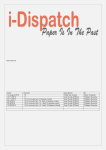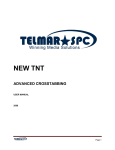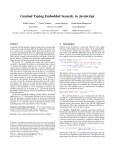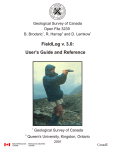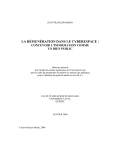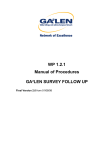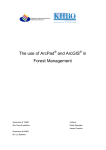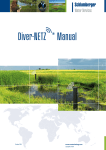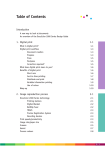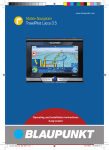Download Understanding Research
Transcript
Understanding Research User Manual 2008 Page 1 Table of Contents Definition of Research ................................................................................................................ 4 The Research Process............................................................................................................... 4 The Research Question ............................................................................................................. 5 Planning and Design: ................................................................................................................. 6 What kind of data is required? ................................................................................................ 6 Secondary Data .................................................................................................................. 6 Primary Data ....................................................................................................................... 6 What is the relevant universe and sample .............................................................................. 7 How will the necessary information be collected ..................................................................... 7 Questionnaire Design ............................................................................................................10 Question Sequence: ..........................................................................................................10 Type of Questions: .............................................................................................................11 Sampling: ..................................................................................................................................14 Selecting the sampling method: .............................................................................................14 Non-probability sampling: ...................................................................................................14 Probability sampling: ..........................................................................................................15 Determining the sample size: .............................................................................................16 Selecting the sample elements: .........................................................................................16 Data Collection:.........................................................................................................................17 Interviewers: ..........................................................................................................................17 Control of Interviewers: ..........................................................................................................19 Data Processing: ...................................................................................................................20 Central Editing: ..................................................................................................................20 Treatment of unsatisfactory questionnaires: .......................................................................21 Coding: ..............................................................................................................................21 Data capturing and storing: ................................................................................................21 Verifying and clearing of the data: ......................................................................................22 Weighting: ..........................................................................................................................23 Analysis and interpretation: .......................................................................................................24 Tabulation: ............................................................................................................................24 Page 2 One-way frequency distribution: .........................................................................................24 Cross-tabulation: ................................................................................................................24 Weights: ................................................................................................................................25 The household weight: .......................................................................................................25 The household decision maker weight: ..............................................................................25 The purchaser weight:........................................................................................................25 Confidence limits: ..................................................................................................................26 Understanding Cross-Tabulation ...............................................................................................28 General Advertising Surveys .....................................................................................................30 AMPS ....................................................................................................................................30 The History of AMPS .........................................................................................................30 1998 – The Beginning Of Huge Change ............................................................................31 Other Factors That Added Impetus To The Process ..........................................................32 What Is Branded AMPS? ...................................................................................................33 Changes In The measurement Of media Other Than Print ................................................33 Current And Future Challenges..........................................................................................34 But where does the process start? .....................................................................................36 TAMS ....................................................................................................................................38 How do we measure Television viewing? ...........................................................................38 RAMS ....................................................................................................................................40 UNIVERSE: .......................................................................................................................40 METHOD: ..........................................................................................................................40 SAMPLE DESIGN: .............................................................................................................40 FIELDWORK: ....................................................................................................................41 ANALYSIS OF RESULTS: .................................................................................................42 Outdoor Research .................................................................................................................43 Page 3 Definition of Research Marketing research is the systematic and objective gathering, recording, analysis and interpretation of data and information, relevant to the identification and solution of any problem in the field of marketing, social and communication decision making; the function which links consumer, customer and public (however defined) to the marketer, communicator or other decision-maker through information, leading to the provision of problem solutions. SAMRA Code of Conduct The Research Process Research Question Report Results Planning & Design Analysis & Interpretation Sampling Data Processing Data Collection Page 4 The Research Question The research process begins at a general level with a Question that needs to be answered. The problem needs to be identified and described. It then needs to be translated into a general research question. This is the single question or hypothesis that best states the overall objective of the research survey. Once the general research question has been selected, it needs to be broken down into various investigative questions. Investigative questions are the questions that needs to be answered in order to answer the general research question; i.e. it is the underlying objectives that has to be met by the research so that the overall objective can be met. Page 5 Planning and Design: During the planning phase, the researcher needs to answer the following questions: What kind of data is required? Secondary Data This is data on the research project already collected by others. Often there are a wealth of information and data available on a research question, in which case it may not be cost effective or necessary to conduct a whole new research project to answer the research question. Primary Data This is data gathered through a research project. Under primary data two types of data can be distinguished: Qualitative Data: The purpose of this data is not to generalize about the specified population, but to uncover new ideas from, or hidden feelings/beliefs of respondents. Qualitative data collection is usually done with small numbers of respondents using unstructured (not unplanned) interviews. This includes methods such as focus groups, one-on-one in-depth interviews and observational methods. Quantitative Data: The aim of this data is to generalise about a specific population, based on the results of a representative sample of that population. Quantitative research generally involves the collection of primary data from large numbers of individuals and projecting the results to a wider population. Methods included are: o Mail surveys o Telephone interviews o Personal interviews o Panels o Diaries Page 6 What is the relevant universe and sample The researcher now needs to identify the target universe and sample characteristics i.e. how many people should be interviewed and who should they be? The most important criterion is that the sample will be totally representative of the population relevant to solving the research question. In some cases the target universe is small enough so that the entire population can be interviewed. In most cases however, the researcher needs to determine the number of respondents required to keep the margin of error as low as possible. How will the necessary information be collected After deciding what type of information would best solve the research question, the researcher should now determine the best method of collecting the data. Mail Surveys: In a mail survey, the researcher sends a structured questionnaire to a selected group of respondents who complete it in their own time and return it to the research unit. Telephone interviews: In telephone surveys, the respondents are phoned, usually at home, and structured interviews are conducted with them. Personal (face-to-face) interviews (e.g. AMPS): This involves trained interviewers using a structured questionnaire to ask questions to a sample of respondents. It is the interviewer‟s task to contact the respondents, ask the questions and record the answers. These interviews can be conducted in a respondent‟s home or at a central point such as a shopping mall. In-home interviews, allows the collection of large volumes of data on just about any subject. The quality of the data obtained, can be enhanced because the interviewer can clarify instructions Page 7 and questions and can make observations about the house, furniture, clothes, etc. of the respondent, allowing him to verify some of the respondent‟s responses. Shoppers in shopping malls generally tend to be in a hurry, which limits the interviewing time and subsequently the amount of data that can be collected. Shopping mall surveys however can be done much quicker than in-home surveys because data collection is from a single location and no travel is required between interviews. Respondents in face-to-face interviews may be reluctant to answer sensitive or embarrassing questions and might provide socially acceptable answers instead. By employing a technique termed Computer-Aided Personal Interviewing (CAPI) in which interviewers read the questions from the screen of a laptop computer and respond by entering the number that corresponds with the respondent‟s answer. Personal interviews can be done much quicker and the results will be available almost instantaneously. Panels: A panel consists of a sample of respondents who have agreed to provide information at specified intervals over an extended period. Panels are used mainly where researchers want to track the purchase or usage of certain products or services. Two main kinds of market measurement panels can be distinguished: o Consumer panels are representative samples of individuals or households whose purchase and usage of defined groups of products are recorded either continuously or at regular intervals. The SAARF RAMS Diaries are an example of a consumer panel. The individuals who are recruited for the AMPS questionnaire, are asked to complete a diary of radio listening on a weekly basis. A structured diary is dropped off at the home of the respondent and the respondent should then enter the times he/she has listen to specific stations on a daily basis. The dairy is then collected at the end of the week and the diary for the next week left behind. The SAARF TAMS Meters are another example of consumer panels. In this case households are recruited for the panel and TV meters are installed on the television sets of participating households. Page 8 The members of the household each receive an identification code or number and this number should be activated in the TV meter every time the person enters the room while the television is on and deactivated when they leave the room. The meter will then record the exact times each member of the household was watching television as well as what stations they watched. Guests watching are also recorded The data from the TV meters are automatically phoned through to the main computer during the night. o Retail panels on the other hand are representative samples of retail outlets whose acquisition, pricing, stocking and display of a defined group of products are recorded either continuously or on a regular basis. Nielsen store audits are an example of this. Page 9 Questionnaire Design After the researcher has answered all the above mentioned questions and made all the necessary decisions, he can design the actual questionnaire to be used to gather the information. It is crucial that all the questions above are answered before the questionnaire design is done. The questionnaire determines the type of data the research will generate, so the type of data needed should be clarified before the questionnaire can be designed. The characteristics of the sample and the interviewing method will influence the design of the questionnaire. Question Sequence: The following should be considered when designing a questionnaire: 1. The first question should be simple and interesting. Its main intention being to put the respondent at ease and motivate him to react to the succeeding questions without suspicion. 2. Be sure to indicate which respondent should answer which questions. Group the questions to be answered by a particular group of respondents. 3. Ensure a logical sequence of questions. As far as possible use the funnel approach, i.e. go from the general to the particular. 4. Position sensitive questions or questions on embarrassing subjects as near to the end of the questionnaire as possible. 5. Questions requiring personal information, for example, age or income may also be sensitive and should also be as near as possible to the end of the questionnaire. 6. Ensure that the structured answers to a question do not provide respondents with answers to questions lower down in the questionnaire. Page 10 Type of Questions: Two basic types of questions can be identified: Structured questions with structured responses Structured questions with unstructured answers: Structured questions with structured answers In this type of questions, the respondent is given a question with various possible answers and has to choose one. Structured questions include: Dichotomous questions: The dichotomous question is a question which offers only two fixed alternatives to choose from, for example Yes/No, Male/Female, etc. Multiple-choice questions with single answers: This is also a fixed-alternative question but it offers more than two fixed alternative answers. Response is restricted to one of the given alternatives. Multiple-choice questions with multiple answers: This type of question allows for more than one answer. Checklists: A checklist typically gives a list of attributes or statements as well as a list of brands or products, the respondents should indicate which brands the statements are associated with. For example: Properties Peter Stuyvesant Rembrand Van Rijn Brands Ransom Select Lexington None of them Liked by women For older people Imported Mild Strong Rankings: In the rank order method the respondent is asked to rank a set of items in terms of a given criterion. For example, the respondent may be asked to rank a list of characteristics of a product in order of importance. The most important characteristic will be given a one and the second most important one a two, etc. Page 11 Grids: This is a simple and straightforward means of collecting information quickly and analysing it in various ways. For example, to find out what respondents eat for their different meals, you can use the following grid: Meals Bread Red meat Bacon Eggs Fish Cheese White meat Rice Pasta Breakfast Lunch Supper Scaled questions: In this type of question, the respondent is required to mark a point on a scale. The following types of rating scales are most commonly used in market research: Graphic rating scale: The respondent is required to indicate his response on a continuum which covers the whole range of possible ratings. For example: How fashion conscious are you on a scale from one to ten: Not very 1 Extremely 2 3 4 5 6 7 8 9 10 Semantic differential scale: The respondent rates the object in terms of a number of rating scales bounded at each end by one of two bipolar adjectives or phrases. Usually the semantic scale has seven points. „Neither-nor‟ is the central point with „somewhat‟ on either side, the next two spaces „very‟ and the outside spaces „extremely‟. For example: How would you rate brand X in terms of health: Healthy Extremely Unhealthy Very Some -what Neither healthy nor unhealthy Somewhat Very Extremely Page 12 Staple scale: This differs from the semantic differential scale in that the adjective pair is replaced by a single adjective or phrase and it usually has 10 scale positions instead of 7. For example: How would you rate store X in terms of low prices: +5 +4 +3 +2 +1 Low Prices -1 -2 -3 -4 -5 Likert scale: Likert developed a verbal scale which requires a respondent to indicate a degree of agreement or disagreement with each of a series of statements, i.e. the respondent has to indicate if he „strongly agrees‟, „agrees‟, „neither agrees nor disagrees‟, „disagrees‟ or strongly disagrees‟ with various statements. Structured questions with unstructured answers In this type of questions allows the respondent to give his own answer in his own way. There are various types of open questions: Straight questions: These are questions with very specific, but a very large number of possible answers e.g. „In what part of Pretoria do you live?‟ Answer: Sunnyside. Straight questions with probing: These are questions with an endless possibility of answers e.g. „Why do you prefer to live in Sunnyside?‟ Answer: „It is central‟. Probe: „What other reasons do you have?‟ Answer: „Rents are relatively low.‟ Sequence-of-mention questions: With these questions, the order of the responses are important, e.g. Please give me the names of three brands of margarine: o First mention: o Second mention: ________________________________ o Third mention: ________________________________ ________________________________ Word association questions: The interviewer says a word and the respondent mentions the first word that comes to mind, e.g. interviewer: „petrol‟; respondent: „power‟. Sentence completion questions: The respondent is required to finish a sentence started by the interviewer, e.g. interviewer: „Cheese tastes best with…‟; respondent: „bread and butter‟ Page 13 Sampling: Once the target population has been determined, the researcher has to identify a reliable sample frame. A sample frame is a record of all the sample units available for selection in the sampling process. A sample frame can be a register of industries, a telephone directory or even a map. A reliable sample frame should: Represent all the elements of the target population. Have no duplication of elements. Be free from foreign elements. After identifying the sample frame there are three steps in the actual sampling process: Selecting the sampling method: Sampling methods may be divided into two broad categories: Probability Non-probability sampling. Non-probability sampling: Three types are usually distinguished: Convenience sampling: As the name implies, respondents are selected on the basis of convenience or availability. For example when a questionnaire is inserted in a magazine and readers are asked to return it. Not all the readers will return it. The readers who do return it are selfselected and might be radically different from the rest of the readers. Page 14 Quota sampling: In a quota sample, the researcher takes explicit steps to obtain a sample similar to the target population in some pre-specified characteristics. For example, if 20% of the target group falls into the A income, he provides for 20% of the sample to fall into the A income. Some quotas are parallel and others are interlocking. In parallel quotas a specific element has to comply with only one characteristic, whereas in interlocking quotas a specific element has to comply with two or more characteristics. Judgement sampling: This is a sample in which the researcher attempts to draw a representative sample by using his judgement. For example when a product is tested in one or two provinces and results are interpreted as being representative of the whole country. Probability sampling: Probability samples differ from non-probability in one very important respect, namely that in a probability sample the sample error for a given sample size can be calculated statistically. Simple random sampling is the main type of probability sampling, with stratified sampling, cluster sampling and two- or multi-stage sampling being variations of this: Simple random sampling: Simple random sampling is unique in that all elements in the population have a known equal chance of being included in the sample. If 100 balls of the same size are put into a container and ten are taken out, the procedure is simple random sampling. Stratified sampling: This is still a form of random sampling, however with stratified sampling the target population is divided into segments or strata and then drawing is done in every stratum on a simple random basis. A stratified sample may be drawn disproportionately; i.e. different portions of the sample may be drawn from each segment. For example, if the population is 40% male and 60 % female, 40 % of the sample should be male and 60% should be female. Page 15 Cluster sampling: With simple or stratified samples the addresses are usually spread over a large area. This has a large implication on the cost and timing of the survey. Cluster sampling saves time and costs. By applying the cluster method one can get a sample of 300 by drawing a sample of 30 and doing an additional nine interviews in the immediate vicinity of each of the 30 addresses. Two- or multi-stage sampling: These samples are drawn using simple random sampling but it is done in various phases. For example if we want to draw a sample of 4,000 smokers in metropolitan areas in South Africa, we will first draw metropolitan areas, then residential areas, then residential blocks and then the elements i.e. smokers. Determining the sample size: The required sample size is determined by the size of the target universe and by the confidence limits you are trying to maintain. It is also influenced by the nature of the information required. If the questions asked are very specific a large sample size is required, to ensure that analyses of the data will be valid. Selecting the sample elements: In most cases this is done by computer. Page 16 Data Collection: Interviewers: In the industry it is generally accepted that a person fitting a specific profile (e.g. female, 25-45, average education, etc.) has the best chance of being an efficient fieldworker. However the survey population and the subject of the survey are equally important in this context. For example if the survey population is black men living in hostels, the first priority will be to recruit black people rather than any other population group. Also if the questionnaire includes sensitive questions, black men may be preferable to black women. Training of the interviewers is of utmost importance. You can spend a lot of time and effort recruiting interviewers but if they are not trained thoroughly, all your time and effort would be wasted. Interviewer training should include the following: The concept of representativeness: Interviewers who understand the concept of representativeness will see why cheating and failure on their part to follow the selection instructions will impair the reliability of the collected information and may also render decisions based on it fatal to the firm concerned. Selecting the elements to be interviewed: Different procedures for selecting the elements to be interviewed are followed in different types of samples. The interviewers should know these procedures and know how and when to use them. Preparation and readiness for the interview: Before going into the field interviewers must: a.) Study the project instructions carefully. b.) Carry out a „dummy‟ interview to familiarise themselves with the questionnaire. c.) Make sure they have all they need e.g. the questionnaire, prompt cards, photographs, etc. Page 17 Appearance and approach: Personal interaction between the interviewer and respondent begins when the respondent opens the door. It is very important that the interviewer knows how to introduce himself and how to „sell‟ the interview to the respondent. Since the respondent should never be made to feel that his visitor belongs to a class different to his own, the interviewer should try to appear classless by avoiding all „betraying‟ externals such as expensive clothing and an affected way of speaking. Asking questions: A number of important rules should be adhered to ensure valid results from the interview: a.) The exact wording in the questionnaire must be used. b.) All the relevant questions in the questionnaire must be asked. c.) The questions are printed in a particular sequence for a special purpose, and the sequence must therefore be strictly adhered to d.) If a respondent gives a „don‟t know‟ answer to a question the interviewer must always make sure it is a genuine „don‟t know‟ and not a „lazy‟ one Probing: A probe is anything done or said by the interviewer to get the respondent to add to or explain something he said, or to bring his attention back to the subject when he has strayed from it. Interviewers should be trained in the different techniques of probing as well as when and how to use it. Recording of answers: All answers and probes should be recorded fully and word for word. Interviewers should thus be trained how to handle respondents who for example, talk too quickly or unclearly. Standard abbreviations can also be used to speed up the recording of answers. Closing the interview: As soon as the interview is over, the interviewer need to briefly report relevant details of the interview on a space provided on the questionnaire. Interviewers should know what aspects of the interview to report (e.g. interruptions, speech, language or hearing defects, etc.). Completed questionnaires should also be edited by the interviewer as soon as possible after the interview to make sure that the writing is legible, all questions have been answered and all necessary explanations given. Page 18 Control of Interviewers: The regular checking of interviewers‟ work by calling back on respondents is of the utmost importance. When the same interviewers are use repeatedly and they know their work is checked on a regular basis, they are less tempted to cheat. By checking new interviewers‟ work errors and misunderstandings can be put right before they become habits. Checks must be made very soon after the interview, because not only do respondents forget what they said in the interview but they also change their minds and opinions. The following types of checks can be done: Postal checks: Reply paid letters or postcards are send to respondents enquiring whether interviews have been conducted with them. Some of the original question can also be included to check that the questions were asked and to check their answers. Personal and telephone checks: Personal checks are the best way of checking on interviewers but it is expensive. Telephone calls can be used as a cheaper alternative but the disadvantage of this is that not all respondents have telephones. Field editing checks: All questionnaires must be edited and where necessary, referred back to interviewers for missing information. A comparison of the questionnaires of individual interviewers reveals whether there are specific patterns in the work of a certain interviewer. Such patterns can indicate cheating, an interviewer misunderstanding a question or interviewers leading respondents to certain answers. Page 19 Data Processing: Central Editing: Each questionnaire is scrutinized or edited before the responses are processed, to see whether the data recorded in the questionnaire are acceptable for use and, to prepare the data for coding and capturing. The following checks are done during central editing: Adherence to sample requirements: Questionnaires should be discarded if they obviously fall outside the sample parameters. Relevance: A respondent who fills in expenditure on liquid detergent under the heading of expenditure on beauty soap has clearly misread the question. Completeness: This implies that all the relevant sections, pages and questions must be completed. Legibility: The seemingly obvious requirement that answers should be legible – especially those to open-ended questions – is frequently ignored under pressure of time during an interview. Comprehensibility: A written answer may be legible but incomprehensible. The meaning of what the respondent wanted to say might not be clear or the interviewer might have use unfamiliar abbreviations. Consistency: A respondent might enter „zero‟ under household expenditure on beauty soap, but circles „brand A‟ as the most frequently used brand in the household. These are inconsistent answers. Uniformity: The same units of measurement should be used throughout in recording the answers to specific questions. If, for instance, the mass and sizes of food packs are not clearly defined respondents may fill in „5 packets‟ or „6 bottles‟. In this case the units may not be uniform, thus rendering the information useless. Page 20 Treatment of unsatisfactory questionnaires: The researcher needs to decide what to do with questionnaires that were not completed correctly. Depending on the type of error the following options are open: Send the questionnaire back to the interviewer and respondent to clear out inconsistencies and unclear answers or to have the missing parts completed Sometimes answers to certain question can be inferred from answers to other questions, in which case it is quite legitimate for an editor to fill in missing answers. Unsatisfactory parts of the questionnaire can be discarded. In this case the number of respondents will vary from question to question. This problem can be overcome by indicating the number or percentage of respondents answering each question on the relevant table. In some cases the respondent might fall outside the sample population or the questionnaire might be so incomplete or incorrect that it would be advisable to discard the entire questionnaire. In surveys with a very high rate of discarded questionnaires the sample loss may be so high that it is no longer representative and it may be necessary to do additional interviews. Coding: This is a technical process whereby codes are assigned to the respondents‟ answers in preparation to their tabulation. Codes are entered by the coder after completion and editing of the questionnaire. For this, the researcher designs and prepares a coding frame, specifying the codes for the various responses after coding a sample of the questionnaires himself. Data capturing and storing: This is the transfer of data from the questionnaires into the computer. Codes can be transferred to coding sheets from which key-punching of data is done or key-punching can be done directly from the questionnaires. Computer aided interviewing is becoming increasingly popular. Using this, the interviewer enters the respondents‟ answers directly into the computer and the data is instantly ready for cleaning and analysis. Page 21 Verifying and clearing of the data: After the data has been captured on the computer, the accuracy of the key-punching need to be verified. This can be done using a technique called double punching. Using this technique the answers of each respondent is key-punched twice and the two files compared with each other. Inconsistencies can then be checked and fixed. We now have a dataset structured as a computer datafile. There might however still be coding and capturing errors in this datafile and we now need to clear the datafile from these errors. Three types of checks can be run to fix these errors: Wild-code check: This check removes so-called „wild-codes‟ from the dataset. Wild-codes are codes that are not defined in the codebook for a particular variable. Consistency check: The next step is to check the consistency of responses for each questionnaire. Computer consistency checks will, for example, check that those respondents who have a mortgage bond also own a house. Extreme case check: An extreme case is defined as a response to a variable that is well out of the ordinary. For example, in an income and expenditure survey amongst households the computer can be commanded to identify all the questionnaire numbers where expenditure exceeds income by more than a specified percentage. Page 22 Weighting: This is a process whereby numerical coefficients (weights or weighting factors) are assigned to each of the elements in a dataset in order to provide them with a desired degree of importance relevant to each other. Usually the sample is weighted up to the target population, i.e. each respondent represents a section of the population and all his responses are made relevant for each of the people he represents. Weighting is also applied to correct purposeful oversampling in, for example, a given metropolitan area or a newspaper‟s circulation area as well as to correct any mismatch between the profile of the achieved sample and the target population. Page 23 Analysis and interpretation: Tabulation: This is the counting of the number of cases which fall into the various categories. After the datafile has been prepared, the computer can usually be instructed to present the data in tabular format. Most computer programs uses two basic methods of tabulation: One-way frequency distribution: This is a tabulation of the spread of data over the various categories for only one variable. The following table reduces 100 responses to 5 categories and illustrates the distribution of the data, showing whether the distribution is an even one or has concentrations in one or more of the categories: Age group Number of respondents 16-24 15 25-34 30 35-49 32 50-64 14 65+ 9 Total 100 The frequency distribution clearly shows a concentration in the 25 to 49 age group. Cross-tabulation: This type of tabulation involves two or more variables. Cross-tabulations are in fact a combination of two frequency distributions: a vertical one and a horizontal one. The tabulation clearly shows the relationship between the two variables. Telmar TNT runs are examples of cross-tabulations. Page 24 Weights: Most surveys are weighted up to the target population. In some cases however it is also necessary to weight it to the number of households or household purchasers. For example on AMPS there are four sets of weights: a personal (Population) weight; a household weight; a household decision maker weight and a household purchaser weight. The type of analysis to be done and the phrasing of the question will determine which weight should be used: The household weight: This is used if you are trying to establish: The number of units of certain products/items in households (e.g. the number of households with TV sets) The amount of money households spend on certain products/items (e.g. the amount of money spent on home improvements) (No personal demographic or habits are applicable when the household weight is being used) The household decision maker weight: This is used if the analysis is to establish media usage or other personal demographics for household items/products (e.g. if you want to do a cross-tabulation of household product usage by media usage). This weight should always be used with a filtered base of male heads of household and female housewives. The wording of the question and purpose of the analysis determines whether analysis by household decision maker weight is meaningful. The purchaser weight: This weight must be used with household products, and only on a filtered base of those wholly or partly responsible for day-to-day purchases of the household. For example when you want to know the number of households using powdered milk. Page 25 Confidence limits: All (random) sample survey results are, unavoidably, subject to a margin of error, i.e. because you only interview a sample of the population and not the entire population, the generalisations you are making by weighting the sample up to the population cannot be done 100% accurately. For this reason we use confidence levels and standard error. Confidence limits are an estimate, derived from a statistical theory, of the range of values in which the “true” figure is likely to lie. Standard error – a measure of the amount by which a survey finding may differ from reality – depending on the sample size. For a confidence level of 95% the precision is 1.96 times the standard error. For example, if, according to your research, 20% of white females use product A and the calculated standard error is 2%, one can be 95% sure that between 16.08% and 23.92% of white females use product A. This is 20% plus or minus 3.92 (2x1.96=3.92). Page 26 Formula: S= √p (100 - p) X 1.96 n S = Standard Error P = Penetration (eg. AR) n = Sample E.G. 3.02 = √ 5 (100 - 5) X 1.96 200 Page 27 Understanding Cross-Tabulation Audience: Always read in ‘000 Resps: Respondents. This is the amount of people that answered the question positive. Read this as you see it (do not add 000) %Col: Reading it by starting with the column heading and read it downwards %Row: Reading it by starting with the row heading and read it upwards. Index: Base is 100. A percent in relation to a norm of 100. For instance, a 123 Index means that a number is 23% higher than the norm. An 83 index means that a number is 17% below the norm. Page 28 Total: The total population o There are 31,109,000 adults in the population o 24,812 people where interviewed, which are grossed up to represent the population Now starting with the men column. Reading the grey block. Audience: There are 15,501,000 men in the population Respondents: 12,405 men where interviewed %Row: 49.8% of the total population are men Audience: 4,190,000 men are between 16-24 years old Respondents: 3,808 men said yes, they are between the ages of 16-24 years old %Col: 27% of men are between 16-24 years old %Row: 51% of all 16-24 year old are men. Index: 2.4% higher than the norm. Page 29 General Advertising Surveys Source: www.saarf.co.za There are three basic surveys that are available to the advertising industry: AMPS (All Media and Product Survey) TAMS (Television Audience Measurement Survey) RAMS (Radio Audience Measurement Survey) Outdoor AMPS The History of AMPS Right from the start of AMPS in 1975 the study, as its name reflects, covered all traditional media as well as products and services. This concept of an All Media and Products Study (AMPS) has proven to have been one of the best decisions ever taken by our industry. Over the years the study has changed and grown from a fairly modest offering to an extremely comprehensive and sophisticated product. In doing this, the simplistic model of 1974 had to change because the world that we live in and the markets that we operate in have changed irrevocably. Thankfully the leaders of our industry saw this and have supported the necessary changes in our AMPS study to meet the needs of the modern fragmented and complex market of 2006. As far back as the eighties, SAARF and media researchers in many countries realized that large changes were going to be required to keep the industry currency surveys relevant in a world of increasing media fragmentation and where the power of demographics was waning. It was clear to many users that the use of demographics alone in targeting was just not adequate anymore and that new thinking was required. Page 30 In South Africa this lead, inter alia, to the creation of the SAARF Living Standards Measure (LSM) which gave a new tool to marketers, media owners and advertising agencies to use in the segmentation of their markets. However, although a great step forward, this was not the alpha and omega of what was required by users. At the same time SAARF was faced with another dilemma namely that the length of the AMPS questionnaire was becoming problematic and something had to be done to solve this problem. 1998 – The Beginning Of Huge Change This was the situation in 1998 when SAARF started considering alternative methodologies to enhance and compliment the trusted face-to-face methodology that is still today regarded as one of the most suitable methodologies for this kind of research. The core of the problem was that the measurement of products and brands on AMPS have been neglected due to the time constraints imposed by an already long questionnaire and therefore a new way of gathering product and brand information had to be developed. This was crucial in order to ensure that users of AMPS would have access to more product categories and brands to enhance their capacity to do target marketing in a market that was getting more complex by the day. During 1999, SAARF decided to investigate the possibility of using a self-completion leave behind questionnaire for the measurement of products and brands. This would reduce the length of the AMPS interview by 12 minutes and would enable SAARF to add more product categories to the survey. It was also decided to develop a questionnaire that was more suitable for South African conditions than those used in other countries and the first pilot study took place later during 1999. The concept was piloted both at a category and brand level and was found to be very successful. Indeed it was found that the addition of the branded information using SAARF‟s unique “brand logo approach” actually improved the quality of the data. It was decided as a first step to implement the unbranded questionnaire in AMPS 2001A and that this would take the number of product categories from about 60 to 155 in one quantum Page 31 jump. The first fully branded questionnaire was planned for and implemented in AMPS 2002B thus providing the first major source of branded information for use by the industry in the history of South Africa. At the same time two other major changes were effected in AMPS: Firstly, SAARF introduced Computer Assisted Personal Interviewing (CAPI) to replace the old pen and paper methodology. At that stage, South Africa was only the third country in the world to have taken this important step with relation to its national currency survey. Secondly, SAARF started to report the AMPS results on a 12-month rolling database. This change was a necessity for providing the industry with larger samples without huge increases in cost and to stabilize the data. Other Factors That Added Impetus To The Process The period 2001 – 2002 was also the time of the big race debate which led to the SAARF Hearings on Race on 27 March 2002. At these hearings it became clear that SAARF would have to spend more time on the development of segmentation tools. In addition, the AAA (now ACA) did a key presentation which again impressed upon us the importance of branded information and gave an even bigger impetus to the move towards the inclusion of many more brands on AMPS than in the past. Dr Nina de Klerk and Ian Shepherd spoke on behalf of the AAA and said: “In advertising planning (both media and message), truly useful segmentation should in any event be derived, bottom up, from brand usage and should not be conveniently replaced by general, predefined segmentation techniques (whether race, age, gender, occupation, life styles, home language, etc). Whilst these generalised descriptions of users and non-users of product categories are valuable in media planning, strategic considerations must be founded on brand usage and behaviour”. Although they were not thinking of AMPS specifically in this regard, it just confirmed what we already new and encouraged SAARF to redouble its efforts to ensure that this important change would be implemented as originally planned during 2002. Page 32 What Is Branded AMPS? At this stage it is important to ensure that everyone is very clear in their minds about what Branded AMPS really is. Branded AMPS is a term that was introduced to use for marketing purposes when the SAARF Board decided to allow SAARF to market the product to users that were prepared to pay for it. It must be stressed that the self-completion questionnaire (sometimes referred to as Branded AMPS) is an integral part of AMPS. Without it, virtually all product data would disappear from AMPS and the single source nature of AMPS would be destroyed. It is thus not a new or separate survey but an essential change that had to be introduced otherwise AMPS would have been in a dead-end. It has also proven to be the most cost effective way of leveraging the industry‟s investment in AMPS as with a very small additional investment in AMPS, nearly 2 000 brands as well as numerous activities and interests have been added for use by all industry players. For target marketing it is essential that the currency survey must contain extensive information on the characteristics of the users of mass media, their media consumption as well as information on their usage/purchasing of products, brands and services. This is the minimum required by users to do segmentation or audience profiling in the markets of today. Changes In The measurement Of media Other Than Print During the period 1998 to 2006 big changes also took place as far as the currencies of Television, Radio and (shortly) Outdoor are concerned. Radio moved to a new methodology called flooding which enabled SAARF to increase the size of the sample to approximately 47 000 diaries a year. The frequency of publication of the data also increased to 6 times a year. As far as Television is concerned, numerous technical changes were made to improve the survey leading up to the biggest single change in the survey since its start in 1989, namely the change to overnight ratings which was implemented in the middle of 2006. The full implications Page 33 of this change will only become clear during 2007 once the industry has fully adjusted to this new methodology. Over the past few years SAARF in conjunction with Nielsen Outdoor in the USA have been working on a new electronic measurement for Outdoor to bring the measurement of this medium in line with those of other traditional media. The implementation of the new methodology started with AMPS 2006 and the first results will be released to the industry in about March 2007. As far as we know, SAARF is the first Joint Industry Committee in the world to have taken this step. It is clear that we have entered an era of change as new technologies will increasingly be employed to meet the needs of users. The electronic measurement of Radio for example is just a question of time as competing technologies sort themselves out and costs, which are currently problematic, come down from the stratosphere. These changes will have implications for the whole of the Media, Marketing and Advertising industry and the future challenges with reference to AMPS must be evaluated in this light. Current And Future Challenges It is clear in the light of the above, that the introduction of the previously mentioned improvements to AMPS does not mean that AMPS is now complete or above further improvement. The industry investigation in 2003 that lead to a reduction in the sample size (virtually to 1975 levels!) and a reduction in the frequency of publication of AMPS to one a year resulted in great unhappiness amongst users of this data. It is of utmost importance that these issues be addressed by SAARF stakeholders as soon as possible. In addition, all indications are that industry currencies in other countries are adapting to changing markets by introducing more and more information in order to provide their users with the necessary information to be able to function effectively in a complex and more fragmented market. Page 34 Industry currencies, to a greater or smaller extent depending on the country, now contain combinations of the following information: 1. Media audience figures 2. Demographics 3. Product information 4. Brand information 5. Information on services such as, for example, Insurance, financial, retail etc. 6. Attitudinal information 7. Activities and lifestyle information 8. Life stages 9. Socioeconomic indexes such as the SAARF SU-LSM 10. Interests, attitudes and opinions 11. Values 12. Psychographics 13. Wide ranging qualitative information on media and products. The basis of AMPS which by nature and design is a behavioural study is however uncontested as it has been proven over and over again that the best predictor of future behaviour is current and past behaviour. It is thus not a question of fundamentally changing the way that we conduct AMPS, but rather how we are going to handle the increased demand for information and accountability. The above developments must not be regarded as nice to have as it is seen by many leading researchers as a necessary change to meet the challenges of the future. Luckily SAARF and AMPS are in a position where these challenges can and will be met to the extent that our stakeholders require. Source: www.SAARF.co.za Page 35 But where does the process start? Sample design The SAARF AMPS® sample is designed by using multi-stage area stratified systematic sampling, pre-stratified by Population Sector (Coloured, Indians and whites form one stratum and black another) Province Community size Gender Age Selection of addresses The residential addresses of almost all urban communities are listed on our contractor Nielsen Media Research‟s geo-frame. The addresses are arranged within each geographic stratum (area) alphabetically by suburb name, then by street name within suburb and numerically by street number within street. Multiple dwelling units such as flats, cluster houses with the same street number are listed individually. The sample is selected in urban areas by using a random starting point, and then selecting systematically with a fixed interval every Nth address number. A cluster of four address are selected at each primary sampling point to save traveling costs. In rural areas (villages and farm) sampling points are selected using maps of the surveyor general‟s office is used to select villages and farms, and at each selected point, case by case. Again a starting point is selected at random and every Nth dwelling is used. Clusters of two (not four as in urban areas) are used. Page 36 Selection of respondents One respondent is selected at every address, using gender and age to ensure a proportionate sample also by these two variables. Inhabitations at mines and hostels and domestic workers are sampled differently in accordance with their gender composition. Geoframe Area Suburb Street St no. Respondent Page 37 TAMS The TAMS Panel of households is designed to measure national television audiences in private households with television and mains electricity. Hostel dwellers and people living in small communities and rural areas are excluded but from April 2007, the rural panel was increased. All members of these households, including children 4 to 11 years and visitors, form the sample for the SAARF TAMS research. How do we measure Television viewing? Since the early eighties, peoplemeters have become the most commonly used method worldwide to estimate television audiences. There are also various research contractors providing their own hardware and software to measure television audiences electronically. All the current systems used what is commonly known as active technology, which means that panel members have to log-in when they are viewing and log-out when they stop viewing, by pressing a button on a remote control unit which is provided. If the household's television does not have a remote control, then a button should be pressed on the set-top unit. Because this method, which relies on the cooperation of household members to press their buttons, is not regarded in many counties as the ultimate solution, various research providers have experimented for many years with developing a 'passive' technology where no activity from panel members is required to register them as viewers and where the system does that automatically. Different technologies such as using face recognition, movement or body heat have been experimented with, but as yet no such system is operational anywhere in the world. Because there are a variety of peoplemeter system in the world which each uses its own technology, a need has developed over the years to set certain international standards. Page 38 Advantages of peoplemeters Because viewing is registered second-by-second it is possible to accurately estimate the audiences of any event, irrespective of the duration of that event. As will become evident later on other methods are limited to quarter hour data. Consequently, it is possible to calculate the audiences of individual breaks and spots, of advertising campaigns, etc. Because peoplemeters monitor actual behaviour continuously, it is possible to estimate the audiences of specific events, not average behaviour like when using other measurement techniques. This makes it possible to report audiences for each episode of programme series, not an average across more than one episode. By doing post campaign analysis after a campaign has been flighted, the success of the campaign can be evaluated in terms of whether the planned target audience had been achieved. Another important advantage of peoplemeters is the speed of reporting. The TAMS results are usually available on Fridays for the reporting week ending the previous Sunday. If required by the industry, it is also possible to provide overnight ratings the day after the event. SAARF has done this, for instance, to report the local audience to Lady Diana's funeral last year. Disadvantages of Peoplemeters Peoplemeter panels are limited to in-home viewing in private households with television and mains electricity, whereas other methods can estimate total viewing, including outof-home viewing and viewing of battery operated sets. Because the peoplemeter equipment is expensive and because it is expensive to operate the system, peoplemeter samples are usually smaller than when another method is used. The limitations of small samples are well known and will be discussed later. Page 39 RAMS The objective of the survey was to gather information on the radio listening habits of the South Africans over a 7-day period. More specifically, the objectives covered: Radio stations listened to during a 7-day period Times listened to each station, for each day of the week, for each quarter hour of the day from 00:00 to 24:00 Radio stations listened to in the past 4 weeks Favourite radio stations UNIVERSE: The survey covered adults, aged 16 years and older, who are living in the nine provinces of South Africa. The same respondent household is used than the AMPS household METHOD: Radio self-completion diaries were placed with respondents to complete in their homes over a 7-day period, for which they were offered a small incentive. After a seven day period, these dairies are picked up and the next set is left with the respondents to complete. Respondents were instructed on how to keep the SAARF RAMS® Diary. SAMPLE DESIGN: A probability sample stratified by area was drawn. The sample was equally apportioned between males and females with the exception of mines, hostels and domestics. At each sampling point a cluster of two addresses was drawn. In each household, the main respondent was selected by means of a Politz grid. Four calls were made before substitution could occur. Page 40 During this survey period, household “flooding” was implemented. In addition to placing a diary with the main respondent, supplementary diaries were placed and completed by all other members of the household aged 16 years and over, in the metro, city and large town portion of the sample. The main advantage of flooding is to allow for reporting on a more robust sample. FIELDWORK: In each year there will be six waves of data. The 2005-2008 SAARF RAMS® contract was awarded jointly to Shonigani (a joint venture between Nielsen Media Research and Plus 94 Harris) and African Response/Proactive Insight. The fieldwork was conducted by interviewers from both companies. A 20% back-check was conducted on all interviewers. Page 41 ANALYSIS OF RESULTS: The findings were based on adults, aged 16 years and over, residing in the Republic of South Africa. Results are weighted up to total population. Special Note: This SAARF RAMS® release uses population figures updated according to the 2001 Census framework, with the BMR projections to the year 2005. The new population figures must be taken into account when comparing thousands to SAARF RAMS® releases prior to the June-September 2005 release. Analysis of results was provided in total, and by demographic breakdowns as follows: Age Community size Gender Home language Household income Household purchaser Languages understood Languages spoken (Other) Level of Education Living Standards Measure Metropolitan area Population group Province Women with children Work status CAUTIONARY NOTE: There are some community radio stations with less than 100 diary keepers in their footprint areas. Users must keep these small sample sizes in mind when examining the data. Page 42 Outdoor Research The Nielsen Personal Outdoor Device (Npod) was used to accurately track respondent travel patterns by capturing the traveling co-ordinates. The Npod strengths include: More advanced chip set than commercial units for greater sensitivity Size of a standard cellphone for ease of carrying Sufficient memory to allow collection every few seconds over 9 days Accurate measurement of location, time, speed and direction of travel The national readership and radio surveys provided the placement interview for Outdoor. At the end of the placement interview, respondents were asked to carry an Npod for 9 days. The Npod was then collected with the Radio Diary and self-completion questionnaires Participants were asked to fill in a short daily travel log to be collected at the same time When travelling in a vehicle, the Npod needed to be placed on the dashboard or at the back window to ensure satellite reception, but this caused a problem as South Africa has a high incidence of theft from vehicles. In order to get past this problem, Nielsen decided to introduce the Elipod which is simply, placing the Npod into a stuff Elephant toy. The Outdoor media owners supplied all their site information (GPS co-ordinates) in an electronic database which is then matched with the co-ordinates from the Npod to produce OTS information Page 43











































